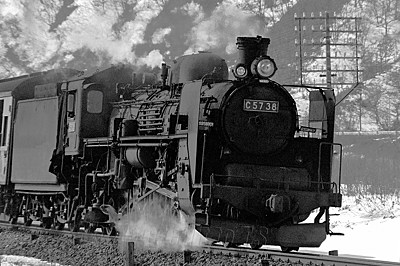
C57 No.38
Mar 1974 on the Muroran line.
Japanese
|
1937 - 1975 A middle to large Tender-Engine for main and sub-main line passenger trains. |

C57 No.38 Mar 1974 on the Muroran line. |
|
The C57 was the first Japanese modern standard passenger engine, and the freight model was D51. C51, C54 and C55 models which all preceded the C57. All of these were Pacific models and the resultant C57 had a wheel arrangement of 4-6-2 and was a culmination of those models. C57's specifications did not represent any big change from C55, except for a boiler pressure of (14 -> 16 kg/cm2). Also the Spoke driving wheel was changed to a Box wheel in appearance. A total of 169 engines were produced during 1937 to 1942. Previous to the war, the C57 received modifications in regard to drawbacks. After WW2, 32 engines were manufactured from 1946 to 1947. The final total was 201 (*) engines. After WW2 of the 32 engines, 11 engines No.190 - 201 had a big design change. (* JGR - 201, Taiwan R.- 14, Total - 215) The first C57 was manufactured at the Kawasaki Rolling Stock Manufacturing Co., it's manufactured number was 1769 during 1938. After its inception, the C57 appeared nearly everywhere on Japanese sub-main lines. C57 was said to be the most popular passenger engine model among Japanese steam locomotives. After WW2, 197 C57s were active with the exception of four (No.74, 75, 99 and 162) which were war-damaged. And two (No.90 and 106) were retired by 1964 due to accidents etc. However, 195 engines were still active during 1965. C57's surplus culling began in 1966, and 5 years later, during 1971, the number was decreased to 103, yet, 32 engines were still active even in 1974. They were ; 1 in the Asahikawa depot (No.87) for the Soya line, 1 in the Naebo depot (No.57) .... Out of service, 6 in the Iwamizawa depot (No.38, 44, 104, 135, 144, and 149) for the Muroran line, 3 in the Hamada depot (No.5, 101 and 156) for the West part of Sanin line, 14 in the Miyazaki depot (No.9, 41, 65, 89, 95, 112, 113, 117, 130, 169, 186, 187, 196 and 199) for the Nippo line, 2 in the Yoshimatsu depot (No.124 and 154) for the Nippo line, 4 in the Kagoshima depot (No.39, 72, 127 and 175) for the Nippo line, Finally, their last appearance was at Iwamizawa depot ..... five (No.38, 44, 57, 135 and 144). Their last operation was during December 1975. More details are mentioned on this website "The Last days of Japanese Steam Engines Part 2" page ...... Two engines were restored, they were C57_1 and C57_180. The C57_180 on the West Banetsu line enjoyed the longest and distance service in Japan of all the restored steam engines. Also restored C57_1 is still active during the spring, summer and fall seasons on the Yamaguchi line and spends the off season at the Umekoji Museum. |
| Primary ran line in last 10 years |
Soya, Muroran, Uetu, Hokuriku, Sobu, Narita, Kisei, Sanin, Bantan, Nagasaki and Nippo line etc ...
| Last line/depot and year |
Muroran line / Iwamizawa depot 1975
| Restored engine (2017) |
2 (No.1, 180)
| Preserved engine (2017) |
30
| |
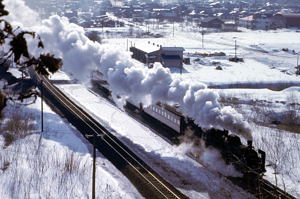
|
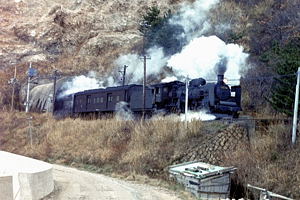
| ||||||||
|
C57_57 at Noboribetu, Muroran line Mar 1973.
|
Shown here we see C57, No.167 under full steam along the Sea of Japan coast under drab December sky. Kosagawa Uetu line Dec 1970.
| 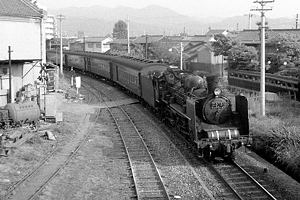
| 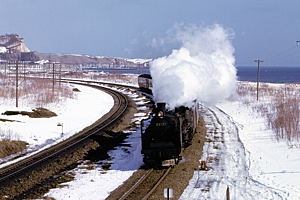
C57, No.5 during May 1969 running in Nijyo Kyoto | on the Sanin line backdropped with Kyoto's skyline
Under full steam this Class C57, | No.57 with the winds of spring, speeds along the Pacific seashore. Class C57 No.38
| 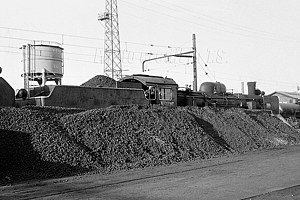
| 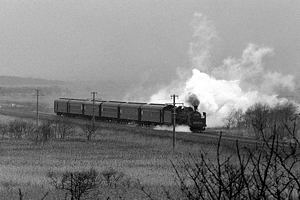
| C57_105 at Shinkoiwa depot (Tokyo), Mar 1969. Toasa, Muroran line, Mar 1971. |
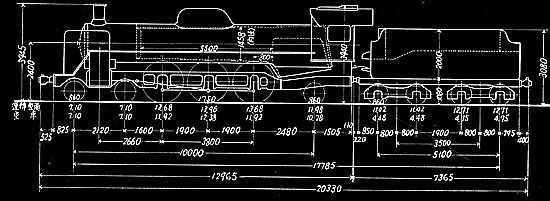
| Configuration | 4-6-2 | Dimensions Length (mm) | 20280 (20260) |
| Engine Weight (Operating tons) | 67.5 (68.3) | Driver size (mm diameter) | 1750 |
| Boiler pressure (Kg/cm2) | 16.0 | Max Tractive effort (tons) | 10.2 |
| Driver Max Power (PS) | 1040 | Max Speed (km/h) | 100 |
| Manufactured years | 1937-1942 1946,47 | Total production | 201 |
| Gauge | 3ft 6in (1067mm) |
* Parenthetic ; After No.170 |
Introduction |
Go to Top |